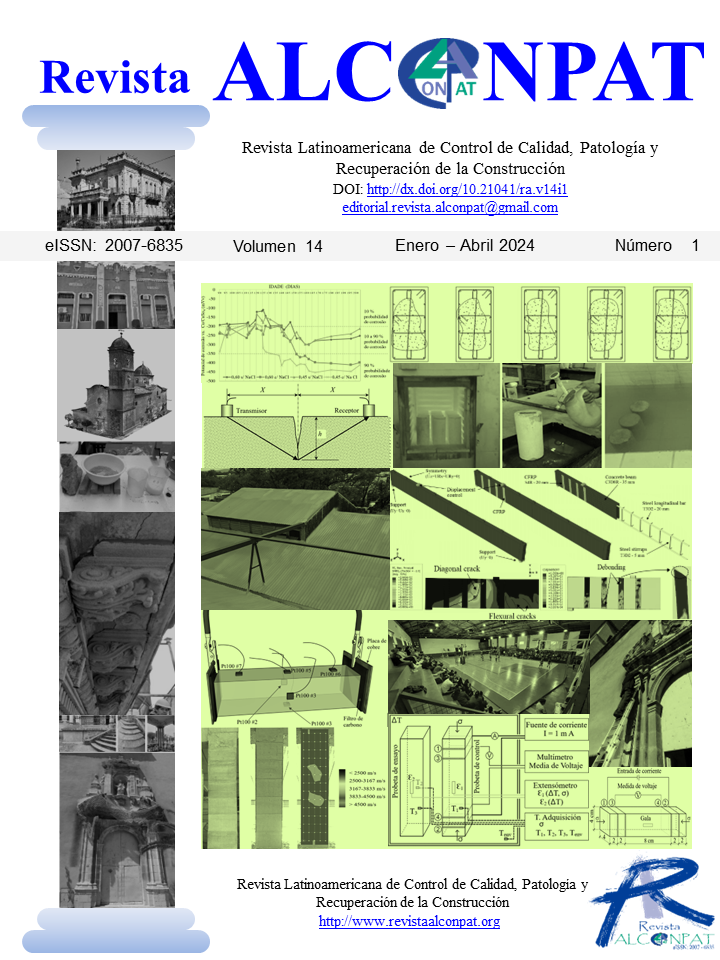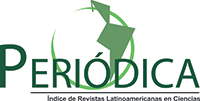Determination of concrete strength and stiffness after fire simulation through multiple regression models between wave propagation and temperature
DOI:
https://doi.org/10.21041/ra.v14i1.663Keywords:
high temperatures, concrete, ultrasonic wave propagation, strength and stiffnessAbstract
The aim of this research was to evaluate the behaviour of the physical, mechanical and elastic parameters of concretes made with different water/cement ratios, subjected to different temperature levels, using ultrasonic wave propagation. After exposure to high temperatures, cylindrical and prismatic concrete samples were subjected to slow and abrupt cooling, demonstrating the influence of the type of cooling on compressive strength, modulus of elasticity, mass loss and wave propagation speed. Statistically significant multiple regression models were developed at the 95% confidence level as predictors of concrete strength and stiffness through the velocities obtained by ultrasound testing, enabling the integrity of structures to be monitored and verified after fire situations.
Downloads
References
American Concrete Institute (2013). ACI 228. 2R. Report On Nondestructive Test Methods For Evaluation Of Concrete In Structures, Detroit.
Associação Brasileira de Normas Técnicas. (1997). NBR 11578: Cimento Portland Composto. Rio de Janeiro.
Associação Brasileira de Normas Técnicas. (2003). Agregados: Determinação da composição granulométrica. Rio de Janeiro.
Associação Brasileira de Normas Técnicas Rio de Janeiro. 2006.
Associação Brasileira de Normas Técnicas. (2009). NBR NM 53. Agregado graúdo – Determinação da massa específica, massa específica aparente e absorção de água. Rio de Janeiro.
Associação Brasileira de Normas Técnicas. (2009). NBR NM 52. Determinação da massa específica de agregados miúdos por meio de frasco Chapman. Rio de Janeiro.
Associação Brasileira de Normas Técnicas. (1998). NBR NM 67. Concreto: determinação da consistência pelo abatimento do tronco de cone. Rio de Janeiro.
Associação Brasileira de Normas Técnicas. (2005). NBR 9778. Argamassa e concreto endurecidos – Determinação da absorção de água por imersão – Índice de vazios e massa específica. Rio de Janeiro.
Associação Brasileira de Normas Técnicas. (2009). NBR 7211. Agregados para concreto - Especificação. Rio de Janeiro.
Associação Brasileira de Normas Técnicas. (2016). NBR 5738. Concreto: Procedimento para moldagem e cura de corpos de prova. Rio de Janeiro.
Associação Brasileira de Normas Técnicas. (2018) NBR 5739. Ensaio de compressão de corpos-de-prova cilíndricos de concreto. Rio de Janeiro.
Associação Brasileira de Normas Técnicas. (2017). NBR 8522. Concreto – Determinação dos modulos estáticos de elasticidade e de deformação à compressão. Rio de Janeiro.
Associação Brasileira de Normas Técnicas. (2019). NBR 8802. Concreto Endurecido – Determinação da velocidade de propagação da onda ultra-sônica. Rio de Janeiro.
Associação Brasileira de Normas Técnicas. (2012). NBR 15200: projeto de estruturas de concreto em situação de incêndio. Rio de janeiro.
Berriman, J., Purnell, P., Hutchins, D.A., Neild, A. (2005). Humidity and aggregate content correction factors for air-coupled ultrasonic evaluation of concrete, Ultrason., Vol. 43, No. 4, Pp. 211–217.
British standards institution (1998). BS 1881 - PART 203: Recommendations for measurement of velocity pulses in concrete. London: p.20.
Camara, L.A., Wons, M., Esteves, I.C., Medeiros-Junior, R. A. (2019). Monitoring the self-healing of concrete from the ultrasonic pulse velocity. Journal Of Composites Science, V. 3, N. 1, P. 16. https://doi.org/10.3390/jcs3010016.
Din En 12504-4: (2004). Testing concrete in structures. Part 4: Determination Of Ultrasonic Pulse Velocity, German.
Estacechen, T. A. C. (2020). Comparativo da resistência à compressão do concreto através de ensaios destrutivos e não destrutivos. CONSTRUINDO, v. 12, n. 2, p. 23-37.
European committee for standardization. (2004). En 1992-1-2: Eurocode 2: Design Of Concrete Structures – Part 1.2: General Rules – Structural Fire Design.
European commitee for standardization (2004). BS EN 12504:4, Testing Concrete. Determination of ultrasonic pulse velocity, Brussels.
Forigo, C. (2017). Determinação da resistência à compressão em concretos expostos a altas temperaturas por meio de ensaios não destrutivos. Dissertação de mestrado. Universidade estadual de maringá. P. 215.
Güneyli, H., Karahan, S., Güneyli, A. (2017). Water content and temperature effect on ultrasonic pulse velocity of concrete. Russian journal of nondestructive testing, v. 53, n. 2, p. 159-166. https://doi.org/10.1134/S1061830917020024.
Gyu-yong, k. I. M., Young-Sun, K. I. M., Tae-Gyu, L. E. E. (2009). Mechanical properties of high-strength concrete subjected to high temperature by stressed test. Transactions of nonferrous metals society of china, v. 19, p. S128-s133. https://doi.org/10.1016/S1003-6326(10)60260-9.
Hwang, E., Kim, G., Choe, G., Yoon, M., Gucunski, N., Nam, J. (2018). Evaluation of concrete degradation depending on heating conditions by ultrasonic pulse velocity. Construction and building materials, v. 171, p. 511-520. https://doi.org/10.1016/j.conbuildmat.2018.03.178.
Kirchhof, L. D., Lorenzi, A., Silva F., Luiz C. P. (2015). Assessment of concrete residual strength at high temperatures using ultrasonic pulse velocity. The e-journal of nondestructive testing, v. 20, n. 7, p. 1-9.
Lafhaj, Z., Goueygou, M., Djerbi, A., Kaczmarek, M. (2006). Correlation between porosity, permeability and ultrasonic parameters of mortar with variable water/cement ratio and water content, Cem. Concr. Res., vol. 36, no. 4, pp. 625–633. https://doi.org/10.1016/j.cemconres.2005.11.009.
Lillamand, I., Chaix, J. F., Ploix, M. A., Garnier, V (2010). Acoustoelastic effect in concrete material under uni-axial compressive loading. NDT & E International, v. 43, n. 8, p. 655-660. https://doi.org/10.1016/j.ndteint.2010.07.001.
Moreno Jr, A. L., Souza, A. A. A. (2010). Efeito de altas temperaturas na resistência a compressão, resistência a tração e modulo de deformação do concreto. Revista Ibracon de Estruturas e Materiais, vol. 3, n. 4, p. 432-448.
Ohdaira, E. And Masuzawa, N. (2000). Water content and its effect on ultrasound propagation in concrete—the possibility of nde, ultrason., vol. 38, nos 1-8, pp. 546–552. https://doi.org/10.1016/S0041-624X(99)00158-4.
Ozawa, M, Morimoto, Hi. (2014). Effects of various fibres on high-temperature spalling in high-performance concrete. Construction and building materials, v. 71, p. 83-92. https://doi.org/10.1016/j.conbuildmat.2014.07.068.
Panzera, T.H., Rubio, J.C., Bowen, C.R., Vasconcelos, W.L., Strecker, K. Correlation between structure and pulse velocity of cementitious composites, adv. Cem. Res, vol. 20, no. 3, pp. 101–108. https://doi.org/10.1680/adcr.2008.20.3.101.
Rilem TC 129-MHT: (2000). Test methods for mechanical properties of concrete at high temperatures. Part1-9.
Rilem TC 200-HTC: (2007). Mechanical concrete properties at high temperatures - modelling and application.
Savaliya, K. D., Thaker, K. K., Dave, U. V. (2014). Comparison between different methods of ultrasonic pulse velocity tests on concrete. International journal of engineering research and applications (ijera), (march), 41–44.
Silva, R. R. C., Gonçalves, R., Bertoldo, C. P. (2020). Classification and inspection of reinforced concrete elements for use in retaining walls using ultrasound tests. Construction and Building Materials, v. 262, p. 120010. https://doi.org/10.1016/j.conbuildmat.2020.120010.
Sutan, N., M., Meganathan, M. A. (2003). Comparasion Between Direct And Indirect Method Of Ultrasonic Pulse Velocity In Detecting Concrete Defects. Journal ntd, vol. 8 no.05, may.
Trtnik, G., Turk, G., Kavcic, F., Bosiljkov, V.B. (2008). Possibilities of using the ultrasonic wave transmission method to estimate initial setting time of cement paste, Cement and Concrete. Res., vol. 38, no. 11, pp. 1336–1342. https://doi.org/10.1016/j.cemconres.2008.08.003.
Turgut, P., Kucuk, O. F. (2006). Comparative Relationships Of Direct, Indirect, And Semi-Direct Ultrasonic Pulse Velocity Measurements In Concrete. Russian journal of nondestructive testing, 2006, vol. 42, no. 11, pp. 745–751. https://doi.org/10.1134/S1061830906110064.
Viana, A. Cl. (2017). Comportamento de ondas ultrassônicas em concreto aquecido até 400 ºc. Dissertação de mestrado, Ufsc-Universidade Federal De Santa Catarina, p.132.
Wendt, S. C. (2006). Análise da mudança de cor em concretos submetidos a altas temperaturas como indicativo de temperaturas alcançadas e da degradação térmica. Dissertação de mestrado, Universidade Federal Do Rio Grande Do Sul, p.188.
Yang, H., Lin, Y., Hsiao, C., Liu, J. Y (2009). Evaluating residual compressive strength of concrete at elevated temperatures using ultrasonic pulse velocity. Fire safety journal, 44(1), 121-130. https://doi.org/10.1016/j.firesaf.2008.05.003.
Ye, G., Van Breugel, K., And Fraaij, A. L. A. (2011). Experimental study on ultrasonic pulse velocity evaluation of the microstructure of cementitious material at early age, Heron, vol. 46, no. 3, pp. 161–167.
Yildirim, H., Sengul, O. (2011). Modulus of elasticity of substandard and normal concretes. Construction And Building Materials, v. 25, n. 4, p. 1645-1652. https://doi.org/10.1016/j.conbuildmat.2010.10.009.
Yüzer, N.; Aköz, F.; Öztürk, L. D. (2004). Compressive strength–color change relation in mortars at high temperature. Cement and Concrete Research, v. 34, n. 10, p. 1803-1807. https://doi.org/10.1016/j.cemconres.2004.01.015.
Zhang, J., Qin, L., And Li, Z.J. Hydration monitoring of cement-based materials with resistivity and ultrasonic methods, Material and Structures. Vol. 42, no. 1, p.15-24. https://doi.org/10.1617/s11527-008-9363-0.
Published
How to Cite
Issue
Section
License
_______________________________
License in effect from September 2020
You are free to:
- Share — copy and redistribute the material in any medium or format for any purpose, even commercially.
- Adapt — remix, transform, and build upon the material for any purpose, even commercially.
- The licensor cannot revoke these freedoms as long as you follow the license terms.
Under the following terms:
- Attribution — You must give appropriate credit , provide a link to the license, and indicate if changes were made . You may do so in any reasonable manner, but not in any way that suggests the licensor endorses you or your use.
- No additional restrictions — You may not apply legal terms or technological measures that legally restrict others from doing anything the license permits.
Notices:
You do not have to comply with the license for elements of the material in the public domain or where your use is permitted by an applicable exception or limitation .
No warranties are given. The license may not give you all of the permissions necessary for your intended use. For example, other rights such as publicity, privacy, or moral rights may limit how you use the material.





















.png)














